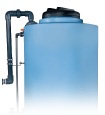When it comes to providing you with the newest innovations in polyethylene chemical storage tanks, Poly Processing stays ahead of the curve. From linear polyethylene parts and cross-linked polyethylene to full drainage systems and tank fittings - we’ve uncovered everything you need to know to safely store chemicals in our article featured in Environmental Science & Engineering Magazine’s June publication. Our marketing team is sharing these insights and more in today’s blog, but you can also access the article on pages 40 to 42 by browsing here.
A chemical storage tank is a small portion of the cost of your multi-million-dollar wastewater treatment plant—but if the tank fails, it could shut down your entire facility. Then the wrong chemical storage tank becomes a costly liability that doesn’t just add expense, but also potential danger and stress.
Need a new chemical tank right away? We’re no strangers to fulfilling tank orders with quick turnaround times. We’ve helped companies who need a storage tank fast, for all sorts of reasons—another linear or FRP tank has failed and they need to replace it immediately, or they forgot to place an order and they’re in a rush to get a tank right now.
Topics:
Chemicals
In 2014, the water storage systems market in North America was valued at $2.45 billion, and it’s projected to top $4 Billion by 2020. As freshwater resources are becoming more scarce in growing population centers, and concerns over water conservation are increasing, potable water storage is becoming a big deal. Municipalities, commercial industries, and even residential markets need to make the most of their potable water storage systems.
Topics:
Applications,
News and Customer Stories
Secondary containment systems are recommended and more andmore required safeguards that can prevent costly damage to equipment and risk to employees if a primary storage vessel is breached. There are several secondary containment options with varying costs, and concrete containment is a popular industry standard. But you may be surprised when you compare the true costs of a poured in place concrete system to Poly Processing’s sophisticated, integrated, double wall tank containment system, the SAFE-Tank®.
Three of the most challenging industries for storing chemicals are also areas we’ve serviced for over 30 years. The plating, mining, and high-tech industries each use aggressive chemicals, and they require chemical storage solutions that can handle highly corrosive compounds. Top companies in the mining, plating, and high-tech industries trust Poly Processing’s innovative technologies to safely contain highly corrosive chemical solutions. Our OR-1000™ and IMFO® tank components are unparalleled when it comes to durability and reliability. Here’s why these industries use our chemical storage solutions:
Topics:
Applications
Odor control is an essential priority for all wastewater treatment plants. Hydrogen sulfide forms in wastewater and creates a strong odor that can be detected in water, and even in surrounding neighborhoods near the treatment plants.
Topics:
Chemicals
Industries that use chemicals and solutions with special chemical standards have to keep a close watch on the storage solutions they rely on. Chemical storage tanks that are susceptible to corrosion or bacterial growth are costly to maintain and replace, and great care must be taken to ensure that the stored materials are preserved.
Topics:
Applications
Selecting the proper tank fitting—and location for the fitting—is an important matter. You need the right fitting for your application, and it’s not always easy to understand which one is the best choice for your needs.
Topics:
Installation and Field Service,
Fittings and Accessories
Steel tanks and vessels provide exceptional strength, but they’re susceptible to chemical corrosion. Any steel tank used for storing harmful chemicals will need to be protected with some form of internal lining/liner. A polyethylene lining system is designed to protect your steel tank against the harshest chemicals to give you broad chemical resistance alongside the durability and strength of a steel tank.
Topics:
Tank Design and Materials



